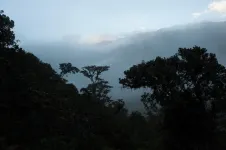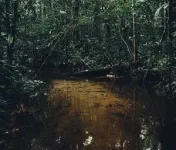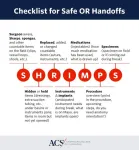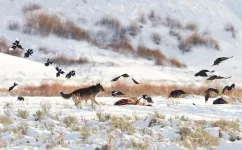(Press-News.org) In the late 2000s, Scott Saleska noticed something strange going on in the Amazon rainforest.
In 2005, a massive drought struck the region. Two years later, Saleska – a University of Arizona professor in the Department of Ecology and Evolutionary Biology – published surprising research that used satellite images to find that the drought resulted in more green growth in large swaths of the Amazon. On the other hand, field researchers saw plants brown and some die in response to the drought.
Research published today in the journal Nature reveals what caused the scientific mismatch. Shuli Chen, a doctoral degree candidate in ecology and evolutionary biology who works with Saleska, is the lead author.
Chen and Saleska teamed up with Antonio Nobre, an Earth scientist at Brazil's National Institute for Space Research, who was using satellites to detect how landscape topography and groundwater tables interact with forests.
The trio and their co-authors from Brazil, the U.S. and the United Kingdom used 20 years of data – from 2000 to 2020, which includes drought data from 2005, 2010 and a more widespread drought in 2015 and 2016 – to tease out how drought impacts the most biodiverse forest on Earth, which spans an area twice the size of India, and is one of the world's largest carbon sinks.
They found that different regions of the Amazon rainforest respond to drought differently because of differences in local forest environments and differences in the properties of trees themselves. This work goes beyond wide-scale climate factors and homes in on how local environments drive drought response, Chen said. The team created maps to illustrate their findings.
In the southern reaches of the Amazon rainforest, mostly over rock formations that geologists call the Brazilian Shield – with relatively fertile soil and forests with shorter trees – drought response was controlled by access to groundwater. Trees with access to shallow water tables "greened up" during drought, the researchers found, while trees over deeper water tables experienced more foliage browning and tree death. In contrast, the northern Amazon, dominated by what geologists call the Guiana Shield – home to tall trees with deep roots and less fertile soil – was more drought resilient regardless of water table depth.
This new understanding of regional differences provides a framework for conservation decisions and improved predictions of forest responses to future climate changes, according to the researchers. It also warns that the Amazon's most productive forests are also at the greatest risk.
"It's like we brought a blurry image into focus," Chen said. "When we talk about the Amazon being at risk, we talk about it as if it were all one thing. This research shows that the Amazon is a rich mosaic in which some parts are more vulnerable to change than others, and it explains why. This is key to understanding the system and ultimately protecting it."
Building the mosaic
The research team used remote sensing satellite data – which relayed forest canopy health by measuring greenness and photosynthetic activity – to track how variations in non-climatic factors including water table depth, soil fertility and overall forest height affect forest resilience in the face of drought.
For trees with access to shallow water tables in the fertile soils of the southern Amazon, droughts result in more growth and healthier canopies for a few reasons.
First, during typical conditions, their roots are submerged in water, which limits access to oxygen. During drought, water recedes a bit, but doesn't go away, exposing more root and allowing an increase in oxygen uptake. At the same time, trees get a photosynthetic boost from the additional sunlight.
Trees in the same region that grow over deeper water tables, on the other hand, have come to rely on rainwater. They are more vulnerable to drought.
The slow-growing trees in the northern Amazon – with their tall canopies, deep roots and relatively infertile soil – have adapted to harsh conditions, Chen said, making them hardy in the face of drought.
The Guiana Shield in the northern Amazon contains less fertile soil and deeper water tables than the Brazilian Shield in the south. These conditions led to slow-growing tall trees with deeper rooting systems able to access the water, making them hardier in the face of drought, Chen said.
"Our results are not just important for the Amazon, it's important for the whole world, because the rainforest has a significant stock of our carbon. If that carbon is lost – because trees burn or are deforested, that adds to carbon dioxide in the atmosphere, which in makes global warming even worse," Saleska said.
Beyond the Amazon
The Amazon rainforest also plays a vitally important role in the Earth's hydrologic cycle.
While the Amazon River is the biggest on Earth – discharging more water to the ocean than the next seven largest rivers combined – an "atmospheric river" of water vapor flows in the opposite direction through the air above Amazon rainforests, carrying up to twice as much water than its terrestrial twin.
Water evaporates from the Atlantic Ocean surface and wind carries it over the eastern Amazon rainforest. When that water falls as rain, it's absorbed by the trees, which then move it up their stems, trunks and vines before emitting it back into the air as water vapor, like slow-motion geysers.
This is happening on a grand scale, with a hundred billion Amazonian trees feeding the atmospheric river that carries water from east to west across the rainforest. Trees in the western Amazon receive about 50% of their water from trees upwind, Saleska said.
"If you imagine either cutting down or losing those trees, because they're vulnerable, and you're getting more droughts, that doesn't just affect those trees, that affects the trees downstream of the atmospheric river too," said study co-author Nobre. "You basically threaten the integrity of the whole system."
This water recycling capability also supplies water to agriculture in other parts of South America, beyond the Amazon, he said.
Saleska, who also serves on the science steering committee of the Science Panel for the Amazon, an international initiative by scientists dedicated to the Amazon, said that the new research will be invaluable for that work.
"If we care about preserving biodiversity, conserving valuable ecosystems, conserving valuable forests, knowing this kind of information is really critically helpful," Saleska said.
END
When in drought: Researchers map which parts of the Amazon are most vulnerable to climate change
2024-06-19
ELSE PRESS RELEASES FROM THIS DATE:
Standardized OR handoffs significantly improve surgical communication and patient safety
2024-06-19
Key Takeaways
The introduction of a standardized handoff protocol substantially improved communication among OR staff, ensuring critical information was transferred consistently.
The enhanced communication reduced potential patient safety risks and highlighted the importance of standardized handoff tools in improving surgical outcomes.
CHICAGO (June 19, 2024) — A new study showcases a successful quality improvement program that significantly enhances surgical safety. By implementing a standardized handoff protocol, known as SHRIMPS, the study demonstrates how ...
Immune response study explains why some people don't get COVID-19
2024-06-19
Scientists have discovered novel immune responses that help explain how some individuals avoid getting COVID-19.
Using single-cell sequencing, researchers from the Wellcome Sanger Institute, University College London (UCL), Imperial College London, the Netherlands Cancer Institute and their collaborators, studied immune responses against SARS-CoV-2 infection in healthy adult volunteers, as part of the world's first COVID-19 human challenge study1. Not all exposed participants went on to develop a COVID-19 infection, ...
New research illuminates the ecological importance of gray wolves in the American West
2024-06-19
Corvallis, OR — A study published today in the journal BioScience sheds light on the importance of gray wolves in western United States. Led by William Ripple, a scientist at Oregon State University and the Conservation Biology Institute, the research delves into the implications of large predator absence on plant and animal communities, and ecosystem functions. It calls attention to “shifting baselines” wherein increasingly degraded conditions are viewed as reflecting the historical state of a system.
"By the 1930s, wolves were largely absent from the American West, including its national parks. Most published ecological ...
Forgotten predators: Ecological understanding is often marred by the exclusion of extirpated species
2024-06-19
New research published in the journal BioScience describes how the removal large predators is often unrecognized in ecological scholarship, creating an issue of "shifting baselines," with profound implications for restoration efforts.
A team led by researchers from Oregon State University, including co-lead authors William J. Ripple and Christopher Wolf, reviewed 96 published studies from 1955 to 2021 that were conducted in 11 national parks where gray wolves had been extirpated. Their analysis found that ...
Inclusive care: Strategies to support infant feeding for parents with disabilities through WIC
2024-06-19
Philadelphia, June 19, 2024 – Infant feeding, involving breastfeeding, formula feeding, and the introduction of solid foods, is crucial for parenting. Pregnant and postpartum individuals with intellectual and developmental disabilities face challenges in infant feeding compared to parents without intellectual and developmental disabilities, often due to ableism and inaccessible care. The Special Supplemental Nutrition Program for Women, Infants, and Children (WIC) program, a federal nutrition initiative, can address these disparities by offering inclusive and accessible support and counseling.
A recent research article in the Journal of Nutrition Education and Behavior, published ...
Computer modelling shows where Arizona’s winter precipitation originates
2024-06-19
The Sun Corridor in Arizona in the semi-arid Southwestern U.S. is a land of seeming unlimited growth that is constantly colliding with physical constraints. It is mountainous but also home to a large valley that includes one of the fastest growing metropolitan areas in the U.S.
While experiencing explosive growth, the Phoenix metropolitan area faces an uncertain future due to prolonged drought and fluctuating seasonal water availability. Planning for the future, especially in terms of water, ...
STUDY: Sourcing genomically diverse seedlings to create climate-change resilient forests brings optimism for partnerships between science and practice
2024-06-19
The roots of the project formed during a CASRI conference in 2018 when experts from various organizations learned about red spruce genetic research being conducted by Keller’s lab and collaborators at University of Maryland with funding by the National Science Foundation. The group saw an opportunity to join forces to take an on-the-ground approach to utilizing the genetic data for red spruce restoration. In 2019, funding from the Wildlife Conservation Society’s Climate Adaptation Fund enabled this group to pursue science-informed restoration at scale.
“Science-informed ...
Could auto-antibodies be linked to severe COVID-19?
2024-06-19
Even though COVID-19 manifests as a mild and short-lived disease in most people, some suffer extremely severe symptoms; in the worst cases, these patients die due to complications such as respiratory failure or thromboembolism. It is well-known that factors such as age and underlying medical conditions like diabetes or immunodeficiencies increase vulnerability to severe COVID-19. However, some patients still experience severe COVID-19 without any apparent reason.
One possible explanation may lie in auto-antibodies, which are antibodies that erroneously target specific proteins produced by one’s own body. In normal circumstances, type I interferons ...
Breakthrough UC San Diego brain recording device receives FDA approval for a clinical trial
2024-06-19
Video: https://youtu.be/-7ggs6e2UXI?si=lnFqEscjJh-91n64
B-roll: https://youtu.be/pvNBa733ICw?si=DotUuQkxVgMQ0jY7
The Federal Drug Administration approved a clinical trial to test the effectiveness of an electronic grid that records brain activity during surgery, developed by engineers at the University of California San Diego.
The device with nanoscale sensors records electrical signals directly from the surface of the human brain in record-breaking detail. The grid’s breakthrough resolution could provide better guidance for planning and performing surgeries to remove brain tumors and treat drug-resistant epilepsy.
The grid’s higher resolution ...
A study led by ISGlobal and IDIAPJGol recommends strengthening immunity against COVID-19 in people with cancer
2024-06-19
Researchers from the Institut d’Investigació en Atenció Primària Jordi Gol (IDIAPJGol) and the Barcelona Institute for Global Health (ISGlobal), a center promoted by “la Caixa” Foundation, have led a study on the effectiveness of vaccines against COVID-19 among cancer patients in Catalonia. The research, published in the journal Nature Communications, recommends administering additional doses of the vaccine among this risk population.
Cancer patients are at increased risk of death from COVID-19, especially ...






